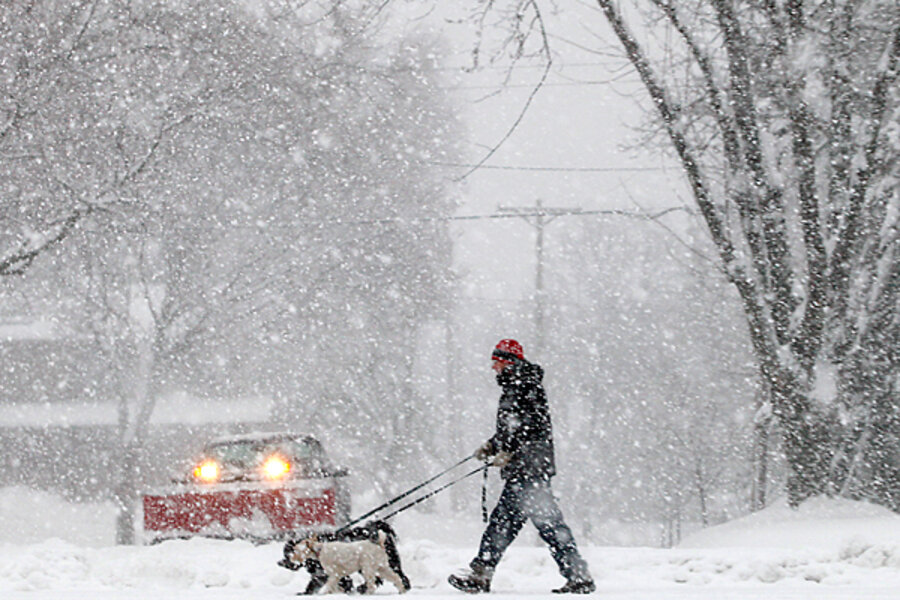How is winter storm affecting holiday travel?
Loading...
| Chicago
An intense winter storm moving across the Midwest not only is affecting holiday travel, but is also likely to factor into a retail season that falls short of earlier projections.
Because of the storm, ShopperTrak, a national retail analysis firm in Chicago, is lowering its holiday sales forecast. It now says that total holiday sales, encompassing November and December, will increase about 2.5 percent from the previous winter season – which is down from the 3.3 percent it projected in September.
But the storm is just one of the recent events affecting retail business, says Bill Martin, ShopperTrak’s founder. Other events that have put a damper on shopping are superstorm Sandy, the national discussion surrounding the “fiscal cliff,” and the mass shooting last week in Newtown, Conn.
The combined effect: Shoppers are likely to have weightier issues on their minds going into the final stretch before Christmas than spending money.
“Sandy took a small slice of the economic pie and disrupted it,” Mr. Martin says. “The fiscal cliff situation and the tragedy in Connecticut both put a different tone on the holiday. People are saying, ‘I want to give my kid a hug for Christmas instead of a toy.’ ”
How much of an impact the current storm will have will depend on the “breadth and depth of the snow” falling through the weekend, he says.
The storm dumped up to eight inches of snow in Nebraska, Iowa, and Wisconsin. That made it not just the first winter storm of the season, but also the “first significant weather system over the last year and a half,” because of last year’s mild winter conditions, says Jim Keeney, a meteorologist with the National Weather Service (NWS).
The wind gusts and snowdrifts are resulting in multistate road closures, school closings, canceled flights, and power outages. These include:
• Airlines at O’Hare International Airport in Chicago have canceled more than 200 flights, and delays are running between 30 to 90 minutes, the Chicago Department of Aviation reports. At Midway International Airport on Chicago’s South Side, Southwest Airlines said it would cancel all flights after 4:30 p.m., central time.
• A 146-mile stretch of Interstate 80 was closed late Wednesday in Nebraska, while Interstate 70 in Colorado was closed east of Denver to the Kansas state line. In Kansas City, Mo., parts of Interstate 29 were closed near the city airport.
• More than 30,000 people in Iowa experienced power blackouts Wednesday. About 16,000 scattered outages were reported in northwest Missouri and northeast Kansas.
• In Wisconsin, Gov. Scott Walker (R) declared a state of emergency and closed most state buildings Thursday, with the exception of the State Capitol in Madison. About 120 Wisconsin National Guard troops were called to active duty at armories throughout the state.
The storm system is moving eastward toward the Great Lakes, where the snowfall is expected to last up to 10 hours. Still, only about 1-1/2 inches of snow is expected to fall in the Chicago area, although heavier snow totals, up to four inches, are expected on the eastern side of Lake Michigan.
“As the snow system continues to move east today, by end of the day, most of the snow should be out of Iowa and Wisconsin and lingering over the Great Lakes area,” Mr. Keeney says. Up to 14 inches are expected in parts of northern Michigan, with five inches already accumulated by Thursday afternoon.
Every region receiving snow this week is expected to have a white Christmas, defined as a snow depth of an inch or more, says AccuWeather in State College, Pa. This includes areas, it adds, that are not necessarily used to heavy snowfall, such as Flagstaff, Ariz., currently saddled with a foot of snow.
“People who got the snow will have a white Christmas. It’s not going anywhere,” says Henry Margusity, a senior meteorologist with AccuWeather.
The area with the best chances of a white Christmas this year is northern New England, which will receive the Midwest storm by Friday.
Despite the sudden blast of inclement weather, as well as lowered expectations in overall holiday sales, consumers are still feeling the need to get out of the house, ShopperTrak says. The firm sees holiday foot traffic increasing 2.8 percent compared with last year, which represents the first increase since 2008.
So while people are getting out more to stores – which has resulted in some boosts, such as an improving unemployment rate – they are more cautious in how much they spend.
“I think everybody is taking pause and seeing where the chips are going to fall” regarding the fiscal cliff, the economy, and their own personal financial outlook, Martin says. “All those things have got to be weighing on the minds of consumers. So maybe, for this season, giving one gift is as good as giving two.”








